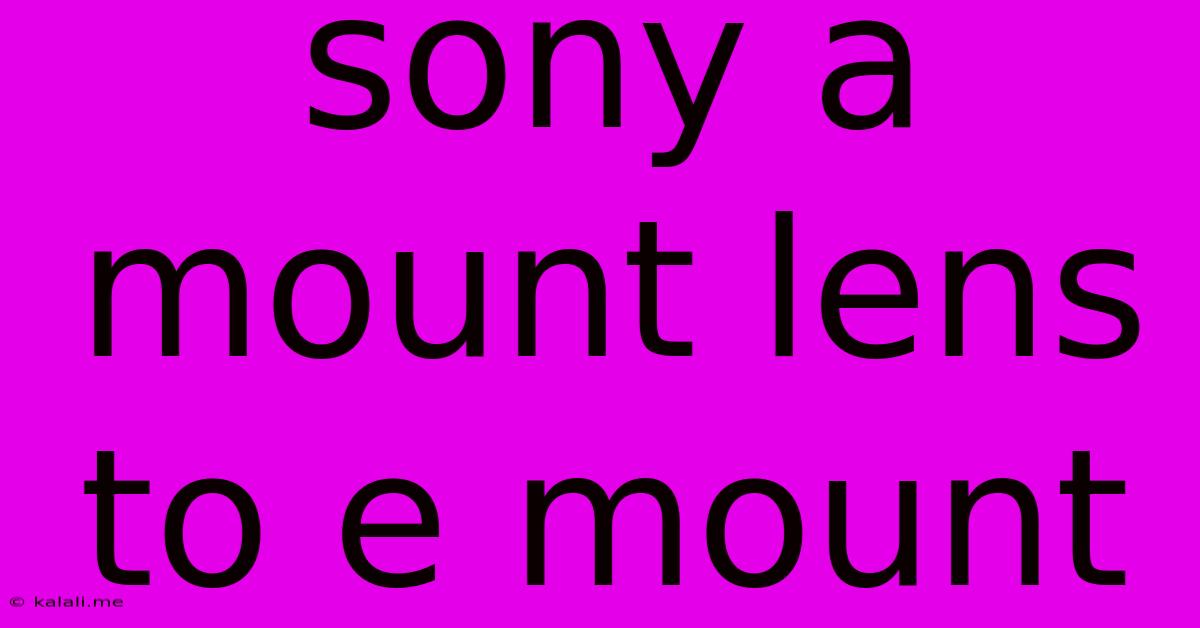Sony A Mount Lens To E Mount
Kalali
May 22, 2025 · 3 min read

Table of Contents
Sony A-Mount Lenses to E-Mount: A Comprehensive Guide to Adapters and Compatibility
Are you a Sony photographer making the switch from A-mount to the newer E-mount system? Don't worry about leaving your cherished A-mount lenses behind! This comprehensive guide explores the world of adapters, compatibility issues, and everything you need to know about using your A-mount lenses on your E-mount camera. This includes understanding autofocus limitations and image quality considerations to help you make the most of your existing investment.
Understanding the Differences: A-Mount vs. E-Mount
Sony's A-mount system, primarily used in their SLT and Alpha DSLR cameras, features a larger, more complex lens mount. E-mount, found in their mirrorless cameras, is significantly smaller and more compact. This difference necessitates the use of an adapter to connect A-mount lenses to E-mount bodies.
The Role of Adapters: Bridging the Gap
Adapters are essentially mechanical connectors that physically attach the A-mount lens to the E-mount camera body. However, simply connecting the lens isn't enough for optimal performance. The adapter's design plays a crucial role in several key aspects:
- Autofocus: Not all adapters provide autofocus functionality. Some offer passive AF, meaning you manually focus the lens, while others utilize electronic communication to enable autofocus. The quality and speed of autofocus can vary significantly between different adapters. Understanding the autofocus capabilities of your chosen adapter is crucial.
- Image Stabilization: Image stabilization (IS) is another important consideration. If your A-mount lens has built-in image stabilization, check if the adapter supports it. Some adapters may not fully support the lens's stabilization features, resulting in potentially blurry images, especially in low light.
- Aperture Control: Most adapters will allow for aperture control, but the method varies. Some may allow electronic aperture control directly from the camera body, while others require manual adjustment of the lens's aperture ring.
Types of Adapters and their Features
The market offers various A-mount to E-mount adapters, ranging in price and functionality. Key features to consider when choosing an adapter include:
- Autofocus capabilities: Passive, contrast-detect AF, or phase-detect AF. Phase-detect AF is generally faster and more accurate.
- Image stabilization support: Check if the adapter preserves the functionality of in-lens image stabilization.
- Build quality and material: A robust adapter is vital to protect your lens and camera. Metal adapters are generally more durable than plastic ones.
- Electronic contacts: For autofocus and aperture control, ensure the adapter has appropriate electronic contacts.
Image Quality Considerations
While using an adapter allows you to use your A-mount lenses, there might be a slight reduction in image quality compared to native E-mount lenses. This is usually minimal and may not be noticeable in most situations. However, factors like adapter quality, lens design, and shooting conditions can affect the final image.
Troubleshooting Common Issues
You may encounter issues like inconsistent autofocus, inaccurate exposure, or communication errors when using adapters. These problems can often be resolved by:
- Using a reputable adapter: Investing in a high-quality adapter from a trusted brand can reduce the chances of problems.
- Firmware updates: Ensure both your camera and the adapter have the latest firmware updates installed.
- Lens compatibility: Certain older A-mount lenses may not be fully compatible with all adapters.
Conclusion: Making the Most of Your A-Mount Lenses
Using an adapter to connect your A-mount lenses to your E-mount camera offers a cost-effective way to utilize your existing investment. By carefully researching adapter options and understanding the limitations, you can seamlessly integrate your A-mount lenses into your mirrorless photography workflow. Remember to prioritize a high-quality adapter for optimal performance and image quality. Happy shooting!
Latest Posts
Latest Posts
-
Can You Eat Kebab The Next Day
May 22, 2025
-
What To Use Instead Of Marjoram
May 22, 2025
-
How To Remove Tar From Fabric
May 22, 2025
-
Radiation Can Pass Through Transparent Surfaces Such As Glass
May 22, 2025
-
Air Conditioning In Car Smells Bad
May 22, 2025
Related Post
Thank you for visiting our website which covers about Sony A Mount Lens To E Mount . We hope the information provided has been useful to you. Feel free to contact us if you have any questions or need further assistance. See you next time and don't miss to bookmark.